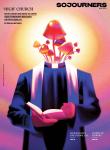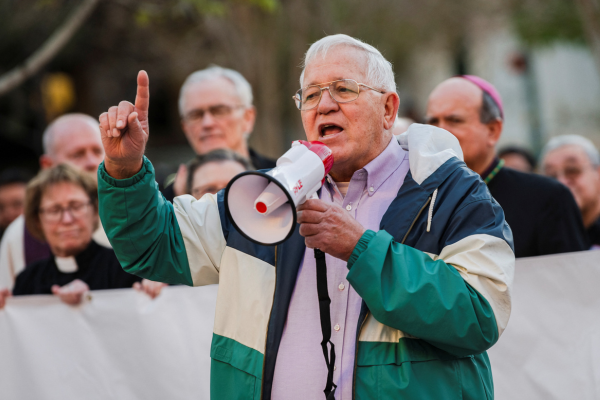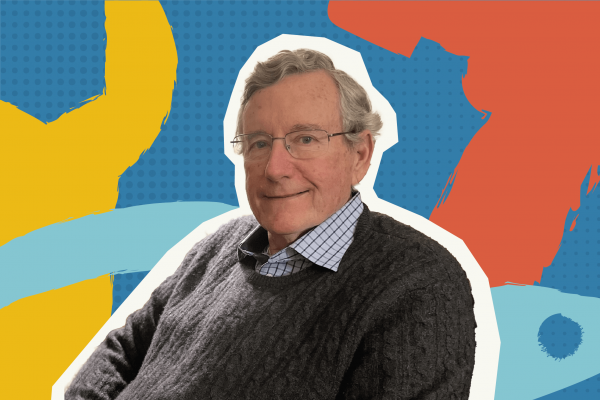When Lindsay Strannigan had extra canned goods, she didn’t want to throw them away. So she posted the cans in a local Buy Nothing group, a Facebook group where members exchange goods free of charge within their neighborhoods. To her surprise, the canned goods were picked up quickly.
“I remember I had this vanilla cantaloupe jam and all this stuff I would never think to can,” Strannigan told Sojourners. “I put out a call on Buy Nothing and my neighbors showed up and wanted my canned goods. They were excited about all the weird oddities.”
The small step into Buy Nothing would expand for Strannigan. She eventually became an administrator for the Brentwood-Darlington group in Portland, Ore. And over time, she formed bonds with her neighbors that exceeded simply passing along extra food: When Strannigan learned through the group that one of her neighbors was diagnosed with leukemia, the members set up a meal train and dropped off other needed items at her home. When Strannigan and her husband both lost their jobs during the pandemic, they found themselves supported by the community.
“It’s just been this way to make connections with people I probably wouldn’t have met otherwise,” Strannigan said. “We can come together and meet needs in our community. It’s not a tax-deductible write off, and there aren’t just takers or givers. It feels more like a circle.”
What is mutual aid?
Buy Nothing groups are just one form of “mutual aid,” an exchange of goods or services without monetary payment. Although neighbors sharing cups of sugar isn’t novel, technology paired with rising transience has changed how people lend to and borrow from their neighbors. When people move more often, Buy Nothing groups and other mutual aid can be helpful in getting to know people next door. Mutual aid can encompass sharing items, such as food or tools, or offering free services like transportation, health care, or translation.
Mutual aid — unlike charity — is based on reciprocity. While everyone who participates doesn’t contribute the same way, each person offers something. Proponents of mutual aid often stress that their involvement is not based on giving from their own excess, but practicing solidarity with their community. Most mutual aid is regionally based, as specific as a neighborhood or broad as large cities.
Kim Olsen, who runs mutual aid outreach for West Valley Homes Yes (WVHY), an organization that supports people experiencing homelessness in Los Angeles, said that mutual aid is primarily about “building community.”
“People say that keeping each other safe is really utopian,” Olsen said. “But the way that we change a lot of the problems in our world is we build community. We don’t just share food; we advocate for each other. I ask you what you need; I don’t tell you what you need. When we recognize individual needs, we recognize the community’s needs and that becomes data. That data informs the systemic changes that need to happen.”
Such was the case for Paul Dono who lives in Los Angeles and, with the help of WVHY, was able to register his car and legally park it. Dono, who is unhoused, now helps other unhoused people through the same process of paying tickets, registering vehicles, and finding insurance.
Dono said that WVHY’s approach is markedly different than city and state programs that promise to help unhoused people but often fail to follow through. The assistance is needed in a city where the police seize the belongings of people experiencing homelessness. Even though the Los Angeles Police Department denies it, Dono said that the LAPD is targeting unhoused people.
“The West Valley Homes Yes crew are nice, friendly people, they are willing to help you, and they actually do things — they get stuff done,” Dono told Sojourners. “When they find out that people don't have this or that, they ask, ‘Well why don't they have that?’ A lot of them would go out and purchase stuff themselves for people on the street that needed it.”
Dono criticized other city organizations, saying many don’t do much besides collect names and information from the unhoused.
“It seems to me they should be hiring the homeless people to do what they’re doing, too. Homeless people have a little bit more understanding of what people are doing and why they’re doing it,” Dono said.
While charity often takes the posture of one person or group giving to or helping another “disadvantaged” group, mutual aid is a collective of people who all give, receive, and help each other in solidarity. Mutual aid also involves the process of listening to the people who are in proximity to each other and getting to know them, rather than donating or volunteering according to the giver’s ethos.
As Olsen put it, “We’re not handing things to less fortunate people to feel good about ourselves.”
“These were our neighbors before they became unhoused, and they’re still our neighbors,” Olsen said. “We are recognizing that we live in a system that’s broken and people are falling through. So we’re not handing down to people, but we’re standing next to them very clearly with the recognition that they are us and we are them.”
A Christian tradition
Such neighborliness is not new to many Christian communities. C.A.M. Mutual Aid is an organization that helps members of the Conservative and Amish Mennonite churches in times of financial crisis. It’s not an insurance company; instead, members agree to assist each other when they suffer a loss of their property or they experience medical bills as the result of injury or illness. And other Christian organizations for sharing health care costs exist similarly (with varying degrees of legitimacy).
Mennonite Church USA, a separate group, has a webpage titled “Why Mutual Aid Matters” which features a communal health care plan for pastors and other church workers in MC USA that has no exclusions for health conditions, as well as congregational subsidies so that every congregation can be covered.
“What sense would it be to have a health coverage plan which some congregations could not afford?” the website reads. “This plan virtually ensures that congregations … can also afford their premiums through the support and mutual aid of others.”
Both the American Friends Service Committee and the Catholic organization Call to Action have webpages that instruct readers how to become involved with mutual aid. The Minneapolis Baha’i Center became an intake and distribution center for first aid supplies, canned food, hygiene products, diapers and more during 2020 protests of police brutality.
For Sr. Bette Ann Jaster, a Dominican Sister of Hope who co-founded EarthLinks, a Denver nonprofit that creates Earth-centered programming with people experiencing homelessness and poverty, gardening has been her choice of mutual aid action.
Jaster, who is now based in New York, saw the 61 acres at The Mariandale Center in Ossining, N.Y., as an opportunity for community building: She started a community garden where local members of the community can come and volunteer or grow herbs and flowers in one of 18 raised beds. Every week, Jaster collects fruits, vegetables, and flowers from an additional community garden on the property and delivers them to Fred’s Food Pantry, which is housed in an Episcopal Church in Peekskill, N.Y.
“We asked what [food] people like when we were planting the garden so that we’ll grow and deliver what the community wants,” Jaster said. “We’re part of a village. We belong together.”
Mutual aid during crises
In 2005, Jimmy Dunson, an organizer with Mutual Aid Disaster Relief, assisted with relief efforts after Hurricane Katrina.
Dunson helped distribute supplies, organized caravans, and drove box trucks into neighborhoods that were impacted. Sometimes, Dunson simply picked up debris or washed dishes.
“I would be distributing food or water, and at the same time somebody would come out with an ice cold water and hand it to me,” Dunson said. “I was amazed at what we were all able to do with very little resources. I was assisting folks, people were assisting me, we were all receiving what we needed and building relationships along the way.”
Nearly 20 years later, Dunson is still working on mutual aid, now out of Tampa, Fla. Mutual Aid Disaster Relief partners with disaster-impacted communities to provide aid through local groups and local organizers. The organization's slogan — common among mutual aid groups — is “solidarity not charity.” Dunson’s work ranges from distributing personal protective equipment to occasionally still driving a box truck.
For Dunson, mutual aid isn’t limited to an organization or a Facebook group: It is a movement and a tactic that all of us can use to bring about a better world.
“Oftentimes in our society, we relate to each other in an inauthentic way that’s just market-based, or we live inside of our bubbles,” Dunson said. “When a disaster strikes, people come out of their homes and meet each other for the first time. In that moment, it becomes clear that our lives before the disaster were missing something. There was a lack of mutual aid, a lack of love, a lack of connection. There was isolation and alienation. And, in coming together to meet each others’ needs and our own needs, it’s a microcosm of that better world that we’re longing to create.”
Dunson said that the evolution of mutual aid during the COVID-19 pandemic, which “has caused a disaster in every community around the world,” has given them hope for the future.
“There’s been a beautiful flowering of local mutual aid efforts all across the world in response to coronavirus,” Dunson said. “I hope it is just a glimpse of what is to come.”
Got something to say about what you're reading? We value your feedback!








